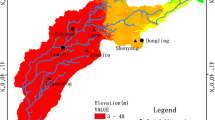Abstract
Annual runoff in Luanhe river basin was detected a downward trend and caused water crisis in Tianjin, China. To quantify the decreased runoff volume, Mann–Kendall test and Pettitt test were employed to check whether there existed significant trend and change points for annual rainfall and runoff time series in Panjiakou reservoir basin and 8 sub-watersheds. It was found that the annual runoff time series had a significant downward trend at 5 % confidence level, and the change point was at 1979 in Panjiakou reservoir watershed. Then double mass curve of annual rainfall and annual runoff was plotted, and two lines were fitted before and after 1979, respectively. Based on this method, the comprehensive effects of land use/land cover change on annual runoff were estimated. To further quantify the contributions of each main factor to annual runoff decrease, water stored in check dams and social water use in different periods were surveyed first. And then multi-linear regression was used to develop the relations between annual runoff and the driven factors. Water area decrease was identified to be the main factor contributing to annual runoff reduction. The results in this study can provide valuable information for water resources planners and policy makers.







Similar content being viewed by others
References
Adeloye AJ, Montaseri M (2002) Preliminary streamflow data analyses prior to water resources planning study. Hydrol Sci J 47:679–692
Christensen NS, Wood AW, Voisin N et al (2004) The effects of climate change on the hydrology and water resources of the Colorado river basin. Clim Change 62:337–363
Dooge JCI, Bruen M, Parmentier B (1999) A simple model for estimation the sensitivity of runoff to long-term changes in precipitation without a change in vegetation. Adv Water Resour 23:153–163
Dubrovsky M, Svoboda MD, Trnka M et al (2009) Application of relative drought indices in assessing climate-change impacts on drought conditions in Czechia. Theoret Appl Climatol 96:155–171
Feng P, Li JZ, Xu X (2008) Analysis of water resources trend and its causes of Panjiakou reservoir. Geogr Res 27:213–220
Ferguson IM, Maxwell RM (2012) Human impacts on terrestrial hydrology: climate change versus pumping and irrigation. Environ Res Lett 7:1–8
Ghosh S, Misra C (2010) Assessing hydrological impacts of climate change: modeling techniques and challenges. Open Hydrol J 4:115–121
Hamed KH (2008) Trend detection in hydrologic data: the Mann-Kendall trend test under the scaling hypothesis. J Hydrol 349:350–363
Kendall MG (1975) Rank correlation methods. Griffin, London
Khan AR (2001) Analysis of hydro-meteorological time series in the upper indus basin: searching evidence for climatic change. International Water Management Institute, Working Paper, pp 23, 31
Kim U, Kaluarachchi JJ (2009) Climate change impacts on water resources in the upper Blue Nile river basin, Ethiopia. J Am Water Resour Assoc 45:1361–1378
Li JZ, Feng P (2007) Runoff variations in the Luanhe river basin during 1956–2002. J Geogrl Sci 17: 339–350
Li HD, Song XQ, Zhou YQ (2004) The impact research of water and soil conservation measures on runoff and sedimentation in Luanhe river basin (1). Haihe Water Resour 23:18–20
Liu YB, Smedt FD, Hoffmann L et al (2004) Assessing land use impacts on flood processes in complex terrain by using GIS and modeling approach. Environ Model Assess 9:227–235
Liu C, Dong ZC, Fang Q et al (2013) Runoff changes in response to climate change and human activities scenarios of Luanhe river basin. Water Resour Power 31:12–15
Ma H, Yang DW, Tan SK et al (2010) Impact of climate variability and human activity on streamflow decrease in the Miyun reservoir catchment. J Hydrol 389:317–324
Mann HB (1945) Nonparametric tests against trend. Econometrica 13:245–259
Milly PCD, Dunne KA (2002) Macro scale water fluxes 2, water and energy supply control of their enter-annual variability. Water Resour Res 38:241–249
Pettitt AN (1979) A non-parametric approach to the change point problem. Appl Stat 28:126–135
Ranger N, Hallegatte S, Bhattacharya S et al (2011) An assessment of the potential impact of climate change on flood risk in Mumbai. Clim Change 104:139–167
Ren LL, Wang MR, Li CH et al (2002) Impacts of human activity on river runoff in the northern area of China. J Hydrol 261:204–217
Saghafian B, Farazjoo H, Bozorgy B et al (2008) Flood intensification due to changes in land use. Water Resour Manag 22:1051–1067
Schulze RE (2000) Modelling hydrological responses to land use and climate change: a Southern African perspective. Ambio 29:12–22
Shahin M, van Oorschot HJL, de Lange SJ (1993) Statistical analysis in water resources engineering. A. A. Balkema, Rotterdam, p 394
Shi XL (2013) Study on distributed hydrological simulation and drought evaluation method in Luanhe river basin based on SWAT model. PH.D. thesis, University of Chinese Academy of Sciences, pp 73
Acknowledgments
This work was supported by National Natural Science Foundation (No. 51209157; 31270510). We are grateful to Hydrology and Water Resource Survey Bureau of Hebei Province for providing so much rainfall and runoff data.
Author information
Authors and Affiliations
Corresponding author
Rights and permissions
About this article
Cite this article
Li, J., Tan, S., Chen, F. et al. Quantitatively analyze the impact of land use/land cover change on annual runoff decrease. Nat Hazards 74, 1191–1207 (2014). https://doi.org/10.1007/s11069-014-1237-x
Received:
Accepted:
Published:
Issue Date:
DOI: https://doi.org/10.1007/s11069-014-1237-x




